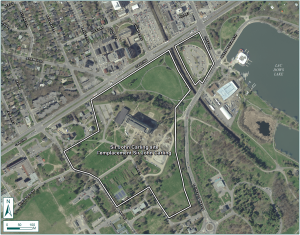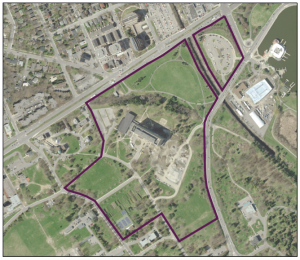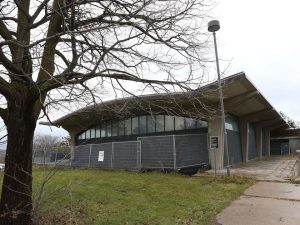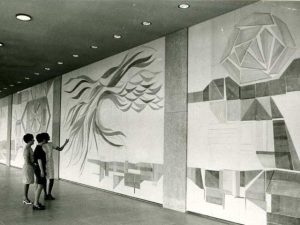The Sir John Carling site now destined to receive the new Civic Hospital campus is not quite the same site that was considered earlier.
The Hospital’s 2007 evaluation exercise provided no specific definition for any site but in the 2016 report for the Hospital by HDR, the SJC site was described as “Located on the northeast portion of the CEF. The parcel is bounded by Carling Avenue, Maple and Birch Drives, Prince of Wales Drive and the CEF Pathway and Queen Juliana Park.” It noted that there are 24 buildings on the site, including nine with a heritage designation. “Extensive demolition and/or relocation of buildings is required to allow for the new build to proceed.” Image of site as is ; image as the HDR report suggested it could become.
The NCC report, however, states that “Site 11 was retained from the 2016 HDR report. However, its boundaries were modified to exclude existing buildings including the Dominion Observatory, creating an irregularly shaped parcel. Additional lands to the east including parcels under PSPC and NCC ownership were added to compensate for the loss in area occupied by existing buildings in the west. The modified candidate site is bounded by Carling Avenue to the north, Preston to the east and Prince of Wales to the southeast. The Sir John Carling Building’s cafeteria annex remains on the site.” It comprises 20 ha (50 acres).
Image (click to enlarge):  and 25-sec video.
and 25-sec video.
+++++++
Councillor David Chernushenko, in an op-ed in the Citizen (Dec. 4, 2016) says that the hospital’s “oversized surface parking ‘requirements'” are a 1970s vision.
Andrew Duffy notes that the SJC site is on the Gloucester Fault but quotes experts who say there is no evidence of movement in the past 10,000 years.
Elisabeth Payne (Dec. 8) signals concern that parking for the new hospital will overwhelm Dow’s Lake. Randall Denley (same date), replying to Chernushenko, opines that, like it or not, the new hospital will be in the parking business.
Less than ten days after the decision on a site was taken, the Province approved $3 million for TOH to start the planning process (Elisabeth Payne, Dec. 12, Dec. 13; Adam Kveton in Metro [no longer online]; Michelle Nash Baker in the Metroland papers). The land transfer process from Public Services & Procurement to The Ottawa Hospital is reported to have begun (Payne, Dec. 15).
David Reevely (Dec. 22, Dec. 24) reports that, as a result of the demolition in 2014, basement cement dust became contaminated with phenols which, mixed with cement dust, started seeping into the soil and the storm sewer, which empties in Dow’s Lake. All sewer connections were severed in the summer of 2016 and temporary silt barriers were installed at the outlet; any contaminated sediment has since been removed. But the gunk in the basement and surrounding soil is still there.
In its assessment, the NCC had done some preliminary soil testing. The NCC-owned parking lot at the Dow’s Lake Pavillion could also be at issue. From the evaluation matrix of the November 24 report, under Contamination at the SJC site (p255):
“Minor contamination — Initial testing completed. Detailed testing underway. (Sir John Carling Building) Medium Priority. Confirmatory sampling completed. (former Site of Temp. Bldg. 8) Low Priority.
Remedial action plan completed. Remediation / risk management underway. (Dows Lake Pavillion parking lot) Low Priority.”
Concludes Reevely:
“Burying contaminated rubble in a spot that seemed likely to be redeveloped even before the hospital came along. Leaving the site connected to an unfiltered storm drain emptying into a historic waterway. Paying little attention to what was coming out of that drain. Treating the substance as all but harmless when it was a big enough problem to keep enforcers’ attention for months after they learned about it.
This seems to have been a minor incident as these things go, but it sure took a lot of screwups to make it happen.”
In reply, Dr. George Neville wrote a letter to the editor, which was not published but is available here with his permission. He notes that the report of phenol leakage requires further investigation as explosives do not leave a phenol residue.
Elisabeth Payne (Jan. 18, 2017) reports that the Heart Institute plans to stay put, possibly as long as 35 years after completion of its $230 million expansion in 2020. The Hospital has been assured by the Heart Institute that the separation “will be more than manageable.”
(On February 1, the Coalition and Heritage Ottawa wrote to the City of Ottawa’s Transportation Committee to register its concern about the continuing erosion of the boundaries of the C.E.F., this time to accommodate the Baseline Road Rapid Transit Corridor.)
On February 7, the Friends of the Central Experimental Farm wrote a firm letter to the NCC’s CEO, urging him to exercise full oversight responsibilities to ensure that the Farm is preserved for all Canadians. The letter summarizes the benefits and significance of the Dominion Arboretum and the Ornamental Gardens and spells out three significant threats:
1- the layout plan for the new hospital poses a threat to both the Arboretum and the Ornamental Gardens;
2- widening of Prince of Wales Drive and any changes to the Driveway and Birch or Maple Drive will do the same; and
3- are further encroachments in the future?
Melissa Murray wrote about it in Ottawa East News (March 13)
+++++++
March 17, 2017
Today Public Works & Procurement Canada released some details about the proposed land transfer: http://www.tpsgc-pwgsc.gc.ca/comm/vedette-features/2017-03-17-00-eng.html. The land to be conveyed has been modified a bit again, creating a larger buffer zone south and east of the Observatory and Azmuth building; north of the Saunders building, AAFC is committed to moving the historic hedge collection but the row of fruit trees along Prince of Wales appears to have no future. Here is the updated picture (click to enlarge):
 There are also some partial cost estimates related to remediating the contamination – at least $11.1 million and more to come. Elisabeth Payne made that the focus of her article in the Ottawa Sun of March 22. Likewise Ryan Tumilty in Metro of March 24, who also quotes MP Poilièvre as saying what a waste this all is compared to just going to Field No. 1. Payne’s March 22 article was in part recycled in the Sun of March 29, giving prominence to Poilièvre’s opinion. Headline: “Concerned about ballooning costs, Poilievre wants hospital site revisited.” George Neville (April 4) responds, saying not enough is known about the contamination problem and citing prominent examples of buildings over fault lines; he calls Poilievre’s utterings “lamentations.” But MP Poilievre persists (April 6).
There are also some partial cost estimates related to remediating the contamination – at least $11.1 million and more to come. Elisabeth Payne made that the focus of her article in the Ottawa Sun of March 22. Likewise Ryan Tumilty in Metro of March 24, who also quotes MP Poilièvre as saying what a waste this all is compared to just going to Field No. 1. Payne’s March 22 article was in part recycled in the Sun of March 29, giving prominence to Poilièvre’s opinion. Headline: “Concerned about ballooning costs, Poilievre wants hospital site revisited.” George Neville (April 4) responds, saying not enough is known about the contamination problem and citing prominent examples of buildings over fault lines; he calls Poilievre’s utterings “lamentations.” But MP Poilievre persists (April 6).
+++++++
March 27 – With a big splash on the Citizen’s front page, an article by Elizabeth Payne on page 5 looks at ways of covering the expected $400 million that will have to be found locally to pay for the $2 billion new campus. Other communities have sold assets (Oakville) or increased property taxes (Windsor, St. Catherines, Burlington, Brampton, but not Toronto). It is thought that in Ottawa not more than $100 million could be raised through charitable donations. On March 30, Mohammed Adam also chimes in on the available options. He includes the hospital selling the Civic Hospital site, forgetting that the land the Civic sits on belongs to the City and will revert to the City if it is no longer used for health care purposes.
+++++++
March 30, 2017
With a prominent teaser on Page 1, the Citizen also prints Elisabeth Payne’s Sun article of March 29 with the headline “Poilièvre calls for rethink of Civic hospital location.” (Citizen, March 30). The web site version retains the Sun article’s headline. C. Dufault responds, pointing out the importance of the experimental fields for food research.
Comment: The argument is based on cost, mostly related to the fact that the Sir John Carling site is a brownfield. Governments can fight over who pays to clean it up, but ultimately it’s the taxpayer who foots the bill.
+++++++
April 6, 2017
Today the NCC Board of Directors approved the transfer of Agricultural and NCC lands to Public Works and Procurement Canada for the purpose of concluding a lease with The Ottawa Hospital for its new campus. The staff report is here. On the video of the meeting, the item runs from 1:53:05 to 2:25:00.
Figure 1 in the staff report names all the buildings on and around the site. Appendix 2 of the report is a 4-page list of Design Principles, adherence to which is a condition of the transfer and will also be a condition of the lease; as well they bind future site-specific designs. Some of these principles include:
2.7 Parking. Reduce surface parking wherever possible and consider stacked parking options. Minimize the extent of paved areas. Develop creative transportation demand management strategies to minimize on-site parking requirements and to limit the extent of modifications required on adjacent routes of importance to the Capital (Prince of Wales, Queen Elizabeth Driveway):
i. Minimize visibility of parking from adjacent Capital landscapes and routes including Queen Elizabeth Driveway and Prince of Wales Drive.
ii. Organize parking lots to provide consolidated soft landscaped areas and opportunities for managing storm water quality and quantity on-site.
5. Environmental Sustainability
Meet leading standards of sustainability, and […]
5.1. […] Ensure compliance with the federal legislative and regulatory framework (e.g. Canadian Environmental Assessment Act, 2012 (CEAA, 2012), National Capital Act and Migratory Bird Convention Act, Species at Risk Act).
5.2. […] Ensure that best efforts are made to protect mature healthy trees of non-invasive species located in and around the site.
5.3. […] Minimize the amount of artificial light at night to reduce light pollution, provided that health and safety regulations, best practices, are applied.
The Principles make no specific reference to the Ornamental Gardens or the Arboretum. The closest it comes is:
1.11 That the importance and character of the Queen Elizabeth / Prince of Wales / Preston intersection be maintained, as the entrance to the NCC’s historic Queen Elizabeth Parkway.
Further fine print reveals that the NCC has a contractual agreement until 2023 to provide parking for 200 cars and 7 buses to serve Dow’s Lake Pavilion and Commissioner Park. The lease agreement will have to continue accommodating that requirement. In discussion, it was admitted that the NCC will lose the revenue it currently gains from the parking lot.
In the end two Directors voted against approval, and one abstained.
+++++++
June 22, 2017
Answers to MP Poilièvre’s questions in the House were tabled on June 21 (Metro, June 22; Ottawa Sun, June 23). Public Works expects the land transfer to take place in 2018. No decision has been made about who’ll pay for clean-up costs.
+++++++
July 18, 2017
Why not a green roof on the new hospital, Edythe Falconer asks in an article in the Summer Newsletter of the Friends of the Farm.
+++++++
August 17, 2017
Metro news obtained documents through Access-to-Information (Ryan Tumilty, August 16), including a report from Stantec that estimates clean-up costs to be $12.1 million, though cheaper options are possible as well. Excess levels of several contaminants within the demolished building envelope were identified. In a follow-up article (August 17), MP Poilièvre is quoted as reiterating that the new hospital should go on “the big open field across the street.” Additional concerns identified in the documents are about the West Annex Building which still has heritage designation; and the parking lot at Dow’s Lake which is under contract with no cancellation clause.
Comment: What’s new?
+++++++
August 18, 2017
Today the City of Ottawa posted zoning and official plan amendment proposals for the future hospital lands (Jon Willing, Ottawa Citizen; CBC News). Comments are due September 15. The proposal is expected to be before Planning Committee on December 22. The planner is Sean Moore (sean.moore [at] ottawa.ca; tel. 613-580-2424, ext. 16481). Included in the documents posted is a brief explanation of the Ministry’s approval process.
+++++++
September 16, 2017
The Greenspace Alliance, along with its partners in the Coalition to Protect the Central Experimental Farm, made a joint submission to city staff regarding the zoning and official plan amendment proposals for the future hospital site. Our position is to promote the smooth transfer of this land for its intended purpose as the site of the new hospital while ensuring that the heritage, greenspace and scientific values of the CEF are protected and maintained.
+++++++
SIDEBAR: New civic group demands a public inquiry into the switch from the NCC’s recommended Tunney’s Pasture site to the Sir John Carling site.
On January 17, 2018, a newly formed group, Reimagine Ottawa, held a press conference at City Hall. Attending were the Honourable Monique Metivier, Dr. Frank Johnson, Dr. David W.O. Rogers, investigative journalist Declan Hill and former Councillor Clive Doucet. Contrasting the very thorough study and public consultation by the NCC to evaluate various sites with the switch, in a matter of days, to the Sir John Carling site, Mme Metivier stated that a public inquiry should shed light on what happened. Media coverage: Laura Osman at CBC News.
UPDATE: On July 4, 2021, In light of the recently announced plans for the new hospital which would destroy much greenspace, Reimagine Ottawa called a rally at the Man with Two Hats statue at Dow’s Lake. Clive Doucet, Angela Keller-Herzog and Noel Lomer spoke. Some 100 people attended. Clive and Noel again demanded a public inquiry about the mysterious switch of sites that had taken place in December 2016. Angela, on behalf of CAFES, spoke about the trees that are being lost all over the city. Media coverage: Krystalle Ramlakhan at CBC News, Bruce Deachman in the Ottawa Citizen, Rob Snow’s podcast for CityNews and Rogers Media.
+++++++
February 23, 2018
A ceremony took place today at City Hall to sign a 99-year, $1/year ground lease agreement for the new campus of The Ottawa Hospital. (Newswire story) Attending were Steven MacKinnon, MP for Gatineau and Parliamentary Secretary to Carla Qualtrough, Minister of Public Works and Procurement; Catherine McKenna, MP for Ottawa Centre and Minister of the Environment and Climate Change; Katherine Cotton, Chair of the Board of Governors of TOH; and mayor Watson, who gave McKenna a dollar.
Other highlights, as reported by David Reevely in the Ottawa Citizen:
+ the Annex (cafeteria) Building, which was saved when the SJCB was demolished, will likely not be kept;
+ the federal government will pay for the contamination clean-up, now estimated to cost $11.8 million;
+ 207 parking spaces must be guaranteed for visitors to Dow’s Lake; and
+ a section of the lease forbids the hospital to construct any standalone commercial building.
With thanks to David Reevely, here is the main text of the ground lease agreement (3.7 MB, 70 pp.). The full document with all its Schedules is 2,418 pages long and 116 MB heavy, with Schedule D (Existing Environmental Reports) taking up the bulk, from pages 130 to 2,255 — a veritable data dump of findings about asbestos, lead, mold, mercury and silica; and reports dating from 2004 to 2017. Only Schedule P (Class D Estimation of Annex demolition) is blank. We provide the following scanned excerpts:
+ title page, table of contents and a page listing the Schedules (5 pp, 2.9 MB)
+ Schedule H: Annex Building Heritage Character Statement (December 2017; 4 pp., 2.5 MB)
+ Schedules L, M and N, depicting NCC and PSPC pathways on the property (3 pp., 4.5 MB)
On March 5, David Reevely devoted a full article on the possible fate of the Annex (cafeteria) Building  and the mural by Takao Tanabe, currently stored in the Neatby Building.
and the mural by Takao Tanabe, currently stored in the Neatby Building.

Comment: So this chapter of the story is now closed. This pretty much ensures there will no backtracking to the previously chosen greenfield site in the heart of the Farm. We have protected a huge piece of the some of the City’s most precious greenspace.
We will remain engaged to ensure that the new hospital construction is sensitive to the heritage, greenspace and scientific values of the landscape in which it is being introduced. (P.J.)
